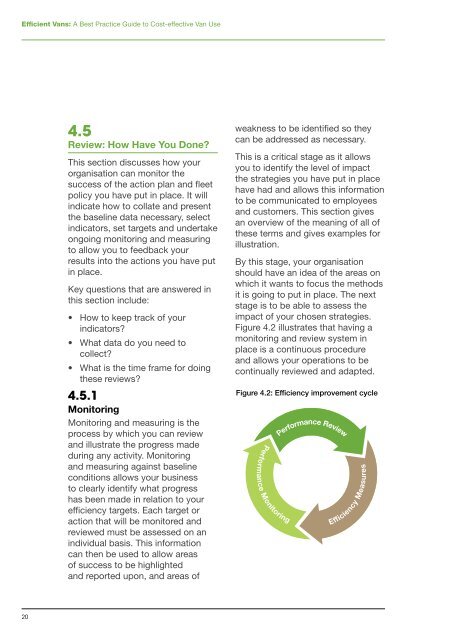Efficient Vans: A Best Practice Guide to Cost - Transport Cafe
Efficient Vans: A Best Practice Guide to Cost - Transport Cafe
Efficient Vans: A Best Practice Guide to Cost - Transport Cafe
Create successful ePaper yourself
Turn your PDF publications into a flip-book with our unique Google optimized e-Paper software.
<strong>Efficient</strong> <strong>Vans</strong>: A <strong>Best</strong> <strong>Practice</strong> <strong>Guide</strong> <strong>to</strong> <strong>Cost</strong>-effective Van Use<br />
20<br />
4.5<br />
Review: How Have You Done?<br />
This section discusses how your<br />
organisation can moni<strong>to</strong>r the<br />
success of the action plan and fleet<br />
policy you have put in place. It will<br />
indicate how <strong>to</strong> collate and present<br />
the baseline data necessary, select<br />
indica<strong>to</strong>rs, set targets and undertake<br />
ongoing moni<strong>to</strong>ring and measuring<br />
<strong>to</strong> allow you <strong>to</strong> feedback your<br />
results in<strong>to</strong> the actions you have put<br />
in place.<br />
Key questions that are answered in<br />
this section include:<br />
• How <strong>to</strong> keep track of your<br />
indica<strong>to</strong>rs?<br />
• What data do you need <strong>to</strong><br />
collect?<br />
• What is the time frame for doing<br />
these reviews?<br />
4.5.1<br />
Moni<strong>to</strong>ring<br />
Moni<strong>to</strong>ring and measuring is the<br />
process by which you can review<br />
and illustrate the progress made<br />
during any activity. Moni<strong>to</strong>ring<br />
and measuring against baseline<br />
conditions allows your business<br />
<strong>to</strong> clearly identify what progress<br />
has been made in relation <strong>to</strong> your<br />
efficiency targets. Each target or<br />
action that will be moni<strong>to</strong>red and<br />
reviewed must be assessed on an<br />
individual basis. This information<br />
can then be used <strong>to</strong> allow areas<br />
of success <strong>to</strong> be highlighted<br />
and reported upon, and areas of<br />
weakness <strong>to</strong> be identified so they<br />
can be addressed as necessary.<br />
This is a critical stage as it allows<br />
you <strong>to</strong> identify the level of impact<br />
the strategies you have put in place<br />
have had and allows this information<br />
<strong>to</strong> be communicated <strong>to</strong> employees<br />
and cus<strong>to</strong>mers. This section gives<br />
an overview of the meaning of all of<br />
these terms and gives examples for<br />
illustration.<br />
By this stage, your organisation<br />
should have an idea of the areas on<br />
which it wants <strong>to</strong> focus the methods<br />
it is going <strong>to</strong> put in place. The next<br />
stage is <strong>to</strong> be able <strong>to</strong> assess the<br />
impact of your chosen strategies.<br />
Figure 4.2 illustrates that having a<br />
moni<strong>to</strong>ring and review system in<br />
place is a continuous procedure<br />
and allows your operations <strong>to</strong> be<br />
continually reviewed and adapted.<br />
Figure 4.2: Efficiency improvement cycle<br />
Performance Moni<strong>to</strong>ring<br />
Performance Review<br />
Performance Review<br />
Effi ciency Measures


